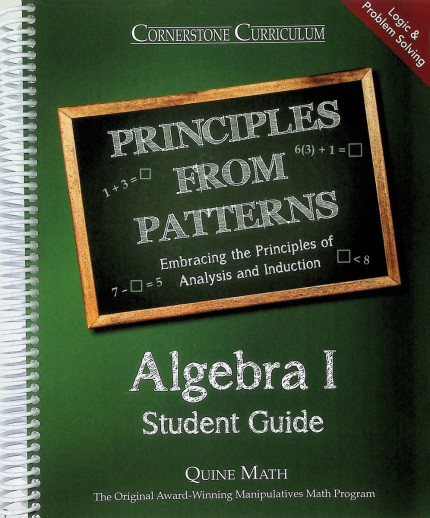We use cookies to make your experience better. To comply with the new e-Privacy directive, we need to ask for your consent to set the cookies. Learn more.
Principles From Patterns - Algebra
Presumably the next step after Making Math Meaningful Level 6, this student-directed workbook covers the fundamentals of Algebra. With clear conceptual presentations, this is indeed written in such a way that the student really can teach himself Algebra. Like the rest of the Making Math Meaningful series, the activities require the student to frequently reflect on conceptual understanding. Questions beginning with "what happens if/when" are used throughout. This workbook consists of 10 chapters covering math sentences, negative numbers, fundamental principles, equations with one or two variables, polynomials, the quadratic formula, factoring, fractions involving variables, and the Pythagorean theorem. ~ Anh
Following the Charlotte Mason philosophy and teaching methods, this complete math program for Levels K-6 focuses on conceptual reasoning from a Biblical Worldview. Levels K-4 are student-teacher interactive, while levels 5-6 are written directly to the student. The Parent Guide (K-4) consists of a series of highly organized activities, or lessons. Chapter objectives are clearly stated. Each lesson is separated into "What I am to Say" and "What I am to Do" sections that the teacher can easily follow. There are three basic lesson types: Observation (Exploring), Interpretation (Explaining) and Application (Expanding) the Concept. While the lesson titles are slightly different between the editions, the instructional focus is the same. In Observation, the child investigates a concept. Manipulatives are used in levels K-4 to provide concrete examples and practice. In Interpretation, math terminology and/or the math formula is given. In Application, the child practices the concept or skill.
A suggested teaching schedule is provided, but the teacher should move at the student's pace. The author recommends that children be taught math during longer periods of time, 1.5-2 hours, for 2-3 days a week. This provides sufficient time for the teacher to introduce whole concepts and the student to digest the information. If a grade level is completed before the school year ends, move to the next level. Otherwise, continue at the student's pace, allowing him as much time as necessary to master the concepts. After completing Level 6, students should be ready for Algebra I.
Level K-4 Sets consist of a Parent- Guide (includes answers to the workbook exercises) and a Student Workbook. Level 5 has a Student Directed Workbook that only provides answers at the end of the workbook. Level 6 has a Student Directed Text only, with answers at the end of the text. Also available is a Manipulative Kit for grades K-4 that includes 50 Unifix Cubes, 100 Counting Chips, and 100 Connecting Links. Other required materials are listed at the beginning of the Parent Guide and with each lesson and can generally be found around the house.
One aspect I liked about the Parent-Teacher Guides is every lesson features an activity. Students cannot be passive about learning math when they are asked to count pennies, dimes, and dollars (to learn about base 10 place value) or to equally divide a loaf of bread for family and friends. This program does a great job presenting "real-life" story problems to which students can easily relate.
Although I agree with Quine in emphasizing concepts over computation, my concern is that there may be students who need more practice in computation than is provided. Personally, the more practice I got, the better my computational skills became. If this is the case for your child, you may need to find a suitable computational supplement. Also, there are no written tests or quizzes for this curriculum. The rationale here is that the parent should know whether or not the child has understood a concept since he/she interacts so closely with the child in this program. At the higher levels, however, for student-directed Levels (5 & 6), there are evaluations by the chapter. ~ Anh/Deanne
| Product Format: | Binder |
|---|---|
| Brand: | Cornerstone Curriculum Project |
| Author: | David Quine |
| Grades: | 8-9 |
| ISBN: | 9780012066829 |

